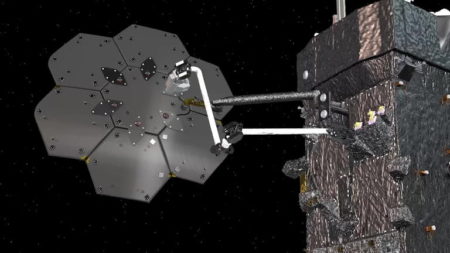
February 4, 2020 – The future of human space activity requires the development of a made-in-space infrastructure. To date, everything humans have put into space has been manufactured on Earth. The gravity well of our planet makes building a space infrastructure this way cost-prohibitive. Even with SpaceX efforts to reuse its Falcon 9 rockets and Dragon capsules, getting stuff into space is costly.
The objective of a long-term human presence off-world, therefore, is to build structures in space from materials available in space. That means extracting resources from low-gravity bodies like asteroids. Even extracting building materials from the lunar surface for use in space would be better than launching payloads from Earth to be used to build a space infrastructure.
That’s what makes the latest NASA initiative to construct and assemble a communication satellite in space using a robotic platform so interesting. Maxar Technologies, the Colorado-based company that recently announced it was putting its robotic arm business up for sale, appears to have won a $142 million contract to assemble spacecraft from parts in low-Earth orbit.
The Space Infrastructure Dexterous Robot (SPIDER), a 4.86 meter (16-foot) robotic arm will be incorporated into a future NASA project named Restore-L. The initial build will create a 9.75 meter (32-foot) lightweight structural beam. This demonstration project will lead to the capacity for NASA to construct spacecraft in orbit. SPIDER recently completed a successful ground demonstration of the technology which will be deployed as early as 2024.
From a Canadian perspective what makes this announcement so interesting is that the SPIDER robot is the evolution of the technology that produced the Canadarm, the robotic arm first featured during the U.S. Space Shuttle program, and subsequently deployed on the International Space Station (ISS).
Restore-L plans to be more than a platform for constructing beams and spars for large satellite arrays. NASA also wants to use it to repair and refuel old satellites that would otherwise become space junk and a permanent hazard.
In its first foray into beam building, SPIDER will use MarkerSat technology developed by Tethers Unlimited, a Seattle-based company that offers in-space servicing and refueling of satellites, in-space manufacturing and assembly of components and systems, and networking for advanced space missions.
The project also includes technology developed at the West Virginia Robotic Technology Center designed to enhance the reliability of building space assemblies in orbit.
On December 30, 2019, Maxar announced it was selling the Canadian subsidiary, formerly MacDonald, Dettwiler, and Associates (MDA), to a Canadian private investment firm for $1 billion CDN ($765 million USD). Pending regulatory approval all of the Canadian business elements of Maxar, including the space robotics technology will once more be in Canadian hands.
It is not clear, therefore, just how much Maxar will be involved in the Restore-L project and the development of SPIDER built on the foundation of the Canadarm and Dextre, the latter, the robotic handyman on ISS used to install and replace exterior equipment with or without extravehicular human missions.
The current iteration of the Canadarm is Version 2, but a Canadarm 3 is planned for the future Lunar Gateway. Canadarm 3 technology will likely be incorporated on SPIDER to provide autonomy for what may become the first in-space manufacturing and assembly platform, and marking the beginning of what will become an off-world infrastructure made in space.








